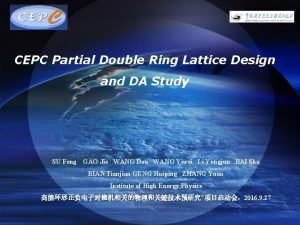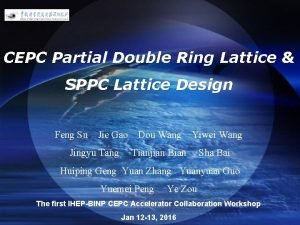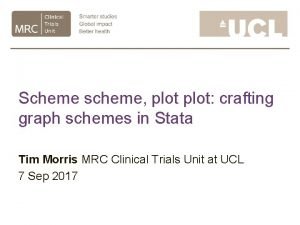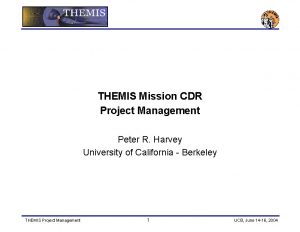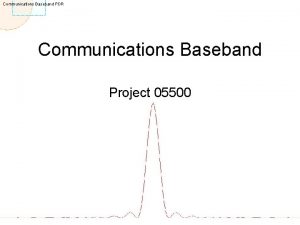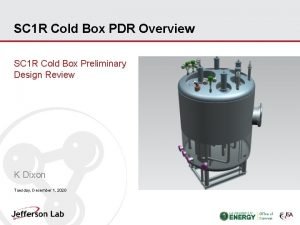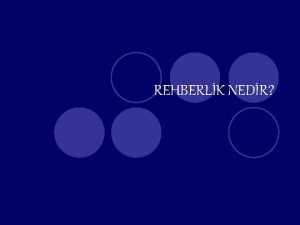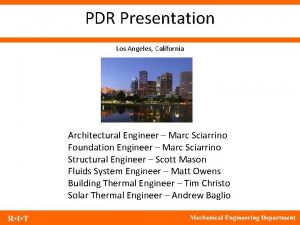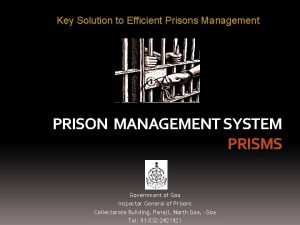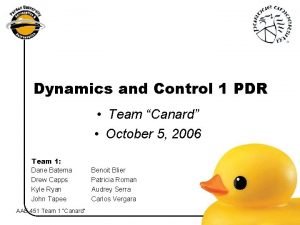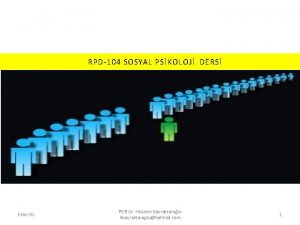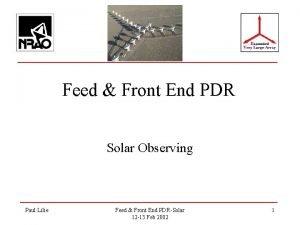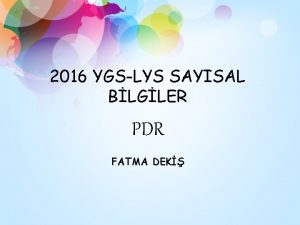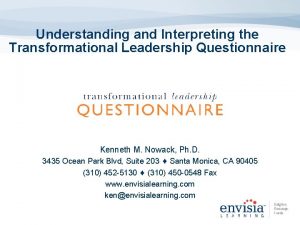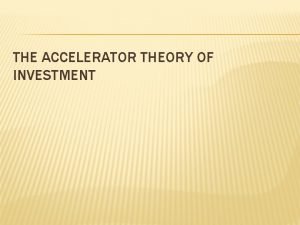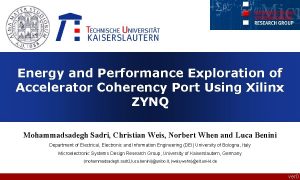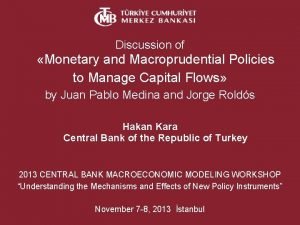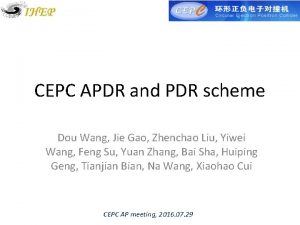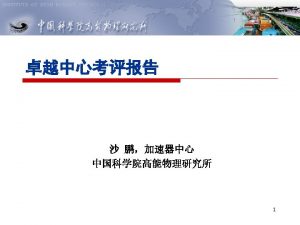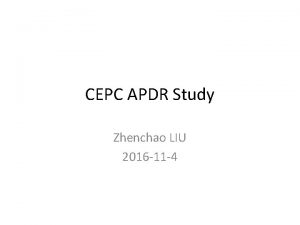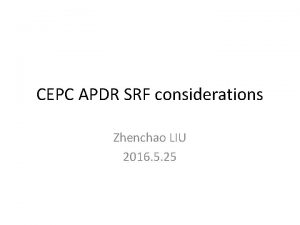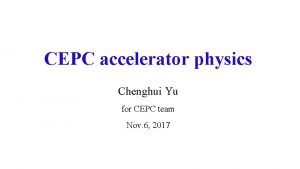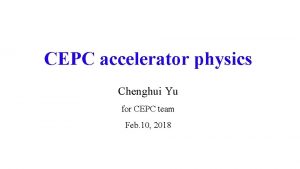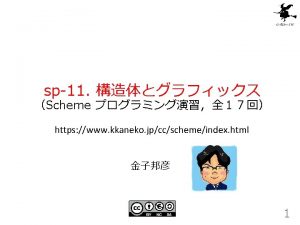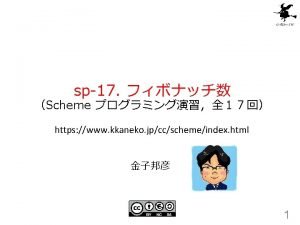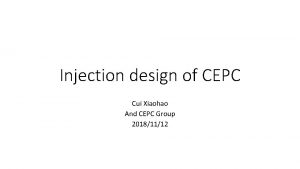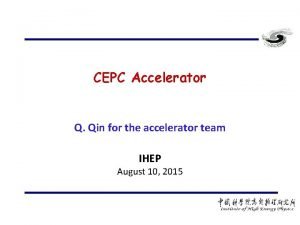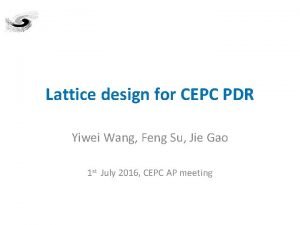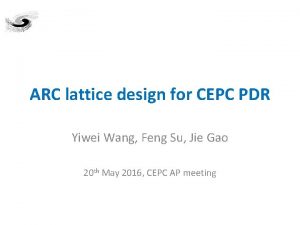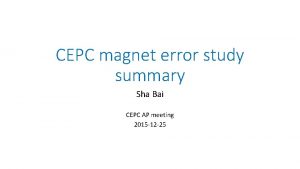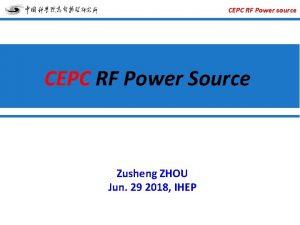Accelerator Design of CEPC PDR and APDR Scheme






























- Slides: 30

Accelerator Design of CEPC PDR and APDR Scheme Dou Wang, Jie Gao, Feng Su, Yuan Zhang, Ming Xiao, Yiwei Wang, Bai Sha, Huiping Geng, Tianjian Bian, Na Wang, Zhenchao Liu, Jiyuan Zhai, Xiaohao Cui, Yuanyuan Wei, Qing Qin 所创新项目CEPC预研中期进展报告会, June 21, 2016, IHEP

Difficulties of CEPC single ring scheme H Number of IPs Energy (Ge. V) Circumference (km) SR loss/turn (Ge. V) Ne/bunch (1011) Bunch number Beam current (m. A) SR power /beam (MW) Bending radius (km) Momentum compaction (10 -5) IP x/y (m) Emittance x/y (nm) Transverse IP (um) x/IP y/IP VRF (GV) f RF (MHz) Nature z (mm) Total z (mm) HOM power/cavity (kw) Energy spread (%) Energy acceptance by RF (%) n Life time due to beamstrahlung_cal (minute) F (hour glass) Lmax/IP (1034 cm-2 s-1) Pre-CDR Low-HOM 2 120 54 3. 1 3. 79 50 16. 6 51. 7 6. 1 3. 4 0. 8/0. 0012 6. 12/0. 018 69. 97/0. 15 0. 118 0. 083 6. 87 650 2. 14 2. 65 3. 6 0. 13 2 6 0. 23 47 0. 68 2. 04 2 120 54 3. 1 1. 0 187 16. 6 50 6. 1 3. 4 0. 06/0. 001 6. 13/0. 018 19. 2/0. 13 0. 031 0. 074 6. 87 650 2. 13 2. 4 1. 0 0. 13 1. 5 6. 1 0. 21 46 0. 66 2. 1 Z 2 45. 5 54 0. 062 0. 13 4800 55. 5 3. 45 100 1. 1 0. 072 6. 1 3. 4 0. 4/0. 0012 0. 9/0. 018 18. 9/0. 15 0. 072 0. 028 0. 68 650 1. 5 0. 55 0. 01 0. 05 4. 5 0. 028 0. 82 1. 04 0. 022 2

Machine constraints / given parameters • • • Energy E 0 Circumference C 0 NIP Beam power P 0 y* Emittance coupling factor Bending radius Piwinski angle y enhancement by crab waist Fl ~1. 5 (2. 6) Energy acceptance (DA) Phase advance per cell (FODO) 3

Constraints for parameter choice Ø Limit of Beam-beam tune shift Fl: y enhancement by crab waist Ø Beam lifetime due to beamstrahlung BS life time: 30 min V. I. Telnov Ø Beamstrahlung energy spread A= 0/ BS (A 3) Ø HOM power per cavity *J. Gao, emittance growth and beam lifetime limitations due to beam-beam effects in e+e- storage rings, Nucl. Instr. 4 and methods A 533(2004)p. 270 -274.

parameter for CEPC partial double ring (wangdou 20160325) Number of IPs Energy (Ge. V) Circumference (km) SR loss/turn (Ge. V) Half crossing angle (mrad) Piwinski angle Ne/bunch (1011) Bunch number Beam current (m. A) SR power /beam (MW) Bending radius (km) Momentum compaction (10 -5) IP x/y (m) Emittance x/y (nm) Transverse IP (um) x/IP y/IP VRF (GV) f RF (MHz) Nature z (mm) Total z (mm) HOM power/cavity (kw) Energy spread (%) Energy acceptance by RF (%) n Life time due to beamstrahlung_cal (minute) F (hour glass) Lmax/IP (1034 cm-2 s-1) Pre-CDR H-high lumi. H-low power W Z 2 120 54 3. 1 0 0 3. 79 50 16. 6 51. 7 6. 1 3. 4 0. 8/0. 0012 6. 12/0. 018 69. 97/0. 15 0. 118 0. 083 6. 87 650 2. 14 2. 65 3. 6 0. 13 2 6 0. 23 47 2 120 54 2. 96 15 2. 85 67 16. 9 50 6. 2 2. 5 0. 25/0. 00136 2. 45/0. 0074 24. 8/0. 1 0. 03 0. 11 3. 62 650 3. 1 4. 1 2. 2 0. 13 2 2. 2 0. 47 36 2 120 54 2. 96 15 2. 67 44 10. 5 31. 2 6. 2 2. 2 0. 268 /0. 00124 2. 06 /0. 0062 23. 5/0. 088 0. 032 0. 11 3. 53 650 3. 0 4. 0 1. 3 0. 13 2 2. 1 0. 47 32 2 80 54 0. 59 15 5 0. 74 400 26. 2 15. 6 6. 1 2. 4 0. 1/0. 001 1. 02/0. 003 10. 1/0. 056 0. 008 0. 074 0. 81 650 3. 25 3. 35 0. 99 0. 09 2 45. 5 54 0. 062 15 8. 5/7. 6 0. 46 1100 45. 4 2. 8 6. 1 3. 5 0. 1/0. 001 0. 62/0. 0028 7. 9/0. 053 0. 005/0. 006 0. 084/0. 073 0. 12 650 3. 9 4. 0 0. 99 0. 05 1. 7 0. 3 1. 1 0. 27/0. 24 0. 68 2. 04 0. 82 2. 96 0. 81 2. 01 0. 92 3. 09 0. 95 3. 61/3. 09 5

Beam-beam simulation IBB: Strong-Strong Beam-Beam Code with Beamstrahlung effect Developed by Y. Zhang@IHEP Case: Pre-CDR Case: H-low power Case: H-high lum Case Z

CEPC Higgs luminosity vs. crossing angle

CEPC Higgs Luminosity vs beam power 8

CEPC PDR Luminosity vs circumference * Fabiola Gianotti, Future Circular Collider. Design Study, ICFA meeting, J-PARC, 25 -2 -2016. 9

100 km CEPC PDR vs Fcc-ee PHOM, CEPC=11. 3 kw • The large difference of Z is due to the constraint for RF HOM power. * Fabiola Gianotti, Future Circular Collider. Design Study, ICFA meeting, J-PARC, 25 -2 -2016. 10

Advantage: bypass (pp) • Avoid pretzel orbit • Accommodate more bunches at Z/W energy • Increase luminosity and reduce beam power with crab waist collision bypass (pp) 11

ARC lattice FODO cell Dispersion Suppressor Sextupole configuration

CEPC Partial Double Ring Lattice 13

Partial double ring FFS design with crab sextupoles Betax=0. 25 m Betay=0. 00136 m K 2 hs=26. 8 m-3 K 2 vs=32. 2 m-3 IP Crab sextupole Critical energy: Ec=190 ke. V Dipole strength: B=0. 019 T Ø The second FFS sextupoles of the CCS-Y section work as the crab sextupoles. 14

Combine with partial double ring lattice 30 mrad 10 m 15

CEPC IR sextupole strength Ec=100 ke. V Ec=190 ke. V

DA of the whole ring (arc+PDR+bypass+FFS) Arc sextupole: 2 groups Crab sextupoles - off • DA (on-momentum): 27 x 57 y • DA ( 0. 5%): 2 x 2 y 17

Magnet field error on DA in CEPC PDR u Main effect coming from the bending magnet no error With bend B*L error (whole ring including FFS) μx= 0 μy= 0 Orbit in X With bend B*L error Orbit in Y With bend B*L error (whole ring including FFS) • With bending magnet field errors, horizontal orbit has changed a lot, but vertical has no change • Tune has changed to be an integer resonance, beam is not stable. • Orbit correction is needed in horizontal • Tracking in 240 turns, coupling factor κ=0. 003 for εy • Could be cured by adjusting the current during commissioning

Multipole errors effect on DA in CEPC PDR Multipole errors of all magnets Multipole errors of bend Multipole errors of quadurpoles Multipole errors of sextupoles • Multipole errors reduce DA a little bit , but not much. It seems to have not much effect on DA, especially of off-momentum DA. • Orbit has no change due to multipole errors.

CEPC Advanced Partial Double Ring Layout I 1/2 RF ARC 1 IP 1_ee RF RF 3 Km APDR 1/2 RF Bypass about 42 m IP 2_pp/IP 4_pp, 1132. 8 m APDR, 1052. 87 m IP 4_pp IP 2_pp APDR C=62967. 86 m RF 2 ARC 4, 24*FODO, 1132. 8 m APDR ARC 2 IP 3_ee 4 Long Straights, 1132. 8 m 4 ARC 3, 79*FODO, 3728. 8 m ARC 3 RF 4 Medium Straights, 566. 4 m 4 ARC 2, 24*FODO, 1132. 8 m ARC 4 1/2 RF 4 Short Straights, 141. 6 m 4 ARC 1, 124*FODO, 5852. 8 m ARC 3 1/2 RF IP 1_ee/IP 3_ee, 2. 968 Km ARC 2 ARC 1 1/2 RF SU Feng 2016. 5. 23

CEPC Advanced Partial Double Ring Layout II 1/2 RF ARC 1/2 RF IP 1_ee 1/2 RF APDR 3 Km 1/2 RF APDR 1/2 RF C=65640. 2 m IP 1_ee/IP 3_ee, 2. 968 Km 1/2 RF IP 2_pp/IP 4_pp, 1132. 8 m APDR, 1052. 87 m 4 Short Straights, 94. 4 m APDR IP 3_ee 1/2 RF 12 Long Straights, 566. 4 m 4 Long ARC, 124*FODO, 5852. 8 m 4 Medium ARC, 104*FODO, 4908. 8 m 4 Short ARC, 14*FODO, 660. 8 m 1/2 RF SU Feng 2016. 6. 2

CEPC Advanced Partial Double Ring Optics PDR 3 PDR 1 APDR Bypass APDR

CEPC APDR SRF considerations • The 8 -double ring and 6 -double ring seem available when using the same parameter as PDR(VRF=3. 62 GV) for HL. The 8 -double ring has a lower phase variation than the 6 -double ring. • The phase region is from 35. 2 -33 degree for bunches in a bunch train for the 8 -double ring HL mode. The phase region is from 35. 2 -32. 3 degree for the 6 -double ring HL mode. • The bunch energy gain in each cavity is constant. • The RF to beam efficiency is ~100%.

8 double ring Number of IPs Energy (Ge. V) Circumference (km) SR loss/turn (Ge. V) Half crossing angle (mrad) Piwinski angle Ne/bunch (1011) Bunch number Beam current (m. A) SR power /beam (MW) Bending radius (km) VRF (GV) f RF (MHz) Cavity No. Cavity gradient APDR(HL VRF=3. 62) APDR (H-low power VRF=3. 53) APDR (Z) 2 120 54 2. 96 15 2. 85 17 x 4 17 50 6. 2 3. 62 650 384 20. 6 35. 2 -33 2 120 54 2. 96 15 2. 67 11 x 4 10. 5 31. 2 6. 2 3. 53 650 384/768/192 20/20/20 33 -31. 6/33 -31. 6 2 45. 5 54 0. 062 15 8. 5 0. 46 275 x 4 45. 4 2. 8 6. 1 0. 357/0. 12 650 48/16/16 16. 2/16. 3/32. 6 80. 1 -79. 9/58. 956. 9/58. 9 -58 260 1389 100. 4 2 6 8 64 206 268 0. 54 0. 838 2 2 E 10 0. 811 1. 656 e 6 0. 196 -0. 138 107. 4 5. 484 20 ~100 2. 5 0. 025 163. 3/81. 6/326. 6 843 62. 7 2/1/4 6/12/3 8/8/8 64/64/64 206/103/412 268 0. 54/0. 27/1. 08 0. 485/0. 24/0. 97 2 2 E 10 1. 242 2. 53 e 6 0. 128 -0. 083 100 5. 484 20 ~100 1. 6 0. 0098 117/350 884 5. 6 2/2/1 6/2/2 1/1/1 8/8/8 206/103 268 0. 54/0. 27 0. 36/0. 18 2 2 E 10 2. 243/0. 76 4. 58 e 6/1. 55 e 6 0. 071/0. 209 -0. 234/-0. 347 65. 3/133 5. 484 20 ~100 1. 7/5. 3/2. 5 0. 0089/0. 0263 Accelerating phase 8 DR H-Low power mode 8 DR Z mode CW power/cavity (k. W) Peak power/train (k. W) Total Power (MW) Cell/cavity Cavity/module Module/station Total module R/Q (Ω) G HOM loss factor/cavity (V/p. C) HOM power/cavity (k. W) Working Temperature(K) Q 0 τ(ms) QL Bandwidth(k. Hz) Detuning F (k. Hz) Stored energy/cavity(J) Frev(k. Hz) Gap length TB (us) η(RF to beam efficiency)(%) Vc decrease(%) TB/τ

(In Feng Su’s talk) CEPC full double ring scheme is also under look…

MDI layout and issues : single partial double ring (In Sha Bai’s talk) Beam background Shielding design Collimator design SC magnet design Beam pipe Solenoid compensation Lumical & fast lumi measurement & feedback ……. . Partial double ring MDI Single ring MDI

CEPC booster design u Wiggling Bend Scheme u Normal Bend Scheme n Both design fulfil the requirement toward CDR Ø For injection, emit of booster@120 Gev should be about 3. 5 E-9 m*rad. Ø 1 percent energy acceptance for enough quantum lifetime. Ø DA_x and DA_y should bigger than 5~6 sigma for injection.


International collaboration 1)王毅伟 2015年 10月4日-11月2日 (KEK Super-KEK B, Japan) 2)边天剑 2016年 1月23日~2016年 4月22日(SLAC, USA)) 3)苏峰 2016年 3月15日-4月15日(BNL, USA) 4)白莎 2016年 3月15日-4月15日 (LAL, France) 5)赵同宪 2016年 2月22日-2016年 4月30日(KEK, Japan)

summary • A consistent calculation method for CEPC parameter choice with carb waist scheme has been created. Larger ring has the potential to reach higher luminosity. • Based on partial double ring scheme, we can get higher luminosity ( 50%) keeping Pre-CDR beam power or to reduce the beam power (30 MW) keeping same luminosity. • FFS with crab sextupoles and lower emittance arc has been designed. On-momentum DA of whole ring is good enough and the optimization of DA bandwidth is ongoing. • Advanced partial double ring scheme has been proposed in order to improve the RF efficiency. 100% efficiency can be achieved. • CEPC full double ring scheme is also under look…
 Cepc logo
Cepc logo Cepc logo
Cepc logo Pdr preliminary design review
Pdr preliminary design review 3 domain scheme and 5 kingdom scheme
3 domain scheme and 5 kingdom scheme Scheme scheme plot plot
Scheme scheme plot plot Ponzi scheme vs pyramid scheme
Ponzi scheme vs pyramid scheme Pdr cdr project management
Pdr cdr project management Risk event life cycle
Risk event life cycle Pdr objectives examples
Pdr objectives examples Communications board
Communications board Pdr compressor
Pdr compressor Radio communication 10 codes security guards
Radio communication 10 codes security guards Uci cinema pdr
Uci cinema pdr Always ready rocketry
Always ready rocketry Pdr temel kavramlar
Pdr temel kavramlar Pdr architects
Pdr architects Pdr prisoner
Pdr prisoner Decontrib pdr dl 50/17
Decontrib pdr dl 50/17 Pdr team
Pdr team Sosyal psikolojinin tarihsel gelişimi
Sosyal psikolojinin tarihsel gelişimi Pdr nin geleceği
Pdr nin geleceği Lilie solar
Lilie solar Narin acapella
Narin acapella 2016 pdr sıralama
2016 pdr sıralama Transformational leadership questionnaire
Transformational leadership questionnaire Limitations of accelerator theory of investment
Limitations of accelerator theory of investment Biztalk swift
Biztalk swift Netbackup accelerator forced rescan
Netbackup accelerator forced rescan Fiscal policy ib economics
Fiscal policy ib economics Accelerator coherency port
Accelerator coherency port Financial accelerator
Financial accelerator
